Common Roof and Siding Problems in Coastal Virginia (And What to Do About Them)
If you live near the coast of the Occoquan Bay, you already know that owning a home here means staying on top of maintenance—especially when it comes to your roof and siding. While the views and fresh air are unmatched, the coastal weather, humidity, and salty environment can be surprisingly tough on your home’s exterior.
Page One Insights, LLC
6/11/20254 min read


Common Roof and Siding Problems in Coastal Virginia (And What to Do About Them)
If you live near the coast of the Occoquan Bay, you already know that owning a home here means staying on top of maintenance—especially when it comes to your roof and siding. While the views and fresh air are unmatched, the coastal weather, humidity, and salty environment can be surprisingly tough on your home’s exterior.
The issues that arise here aren’t always the same as what homeowners deal with further inland. Knowing what to watch for (and when to call in help) can make all the difference when it comes to protecting your home and your investment.
1. Salt Air Exposure
One of the more unique challenges to coastal Virginia is the constant presence of salt in the air. While it’s easy to forget it’s there, this fine mist can slowly eat away at your siding and roofing materials over time—especially metal components like flashing, nails, gutters, and vents.
What to watch for:
Rust or corrosion on metal fixtures
Fading or discoloration on siding or trim
Loose or corroded fasteners on roof edges
What you can do:
Consider switching to corrosion-resistant materials like stainless steel or coated aluminum for flashing and fixtures. Fiber cement siding also holds up better than wood or standard vinyl near salty air. And don’t skip regular rinsing—spraying your siding and soffits with clean water every few months helps keep salt buildup to a minimum.
2. High Humidity and Moisture Retention
Humidity is a fact of life along the coast—and in the Occoquan Bay area, it often sticks around long after the storm clouds clear. This kind of damp environment encourages mildew, algae, and mold growth on both roofs and siding, especially on surfaces that don’t get a lot of sun.
What to watch for:
Green or black streaks on roof shingles
Siding that feels soft or spongy to the touch
A musty smell in attics or around exterior walls
What you can do:
Regular cleanings and a proper ventilation system go a long way. Algae-resistant shingles are a great option if your roof is due for replacement. For siding, choosing moisture-resistant materials and installing a proper house wrap behind the siding can help prevent trapped moisture and rot. Ventilation in attics and soffits is also key to reducing internal humidity.
3. Heavy Wind and Storm Damage
With strong coastal storms hitting several times a year, wind damage is a serious concern for homeowners in this part of Virginia. Winds coming off the water tend to pick up speed and hit structures harder than in landlocked areas.
What to watch for:
Lifted or missing shingles
Siding panels that have pulled loose or cracked
Flapping soffit vents or bent guttering
What you can do:
Reinforce roofing with storm-rated fasteners or choose architectural shingles, which are heavier and more wind-resistant than standard 3-tab varieties. For siding, opt for wind-tested materials with reinforced nailing flanges. After any storm, do a walkaround of your home and take photos of anything that looks out of place.
4. Foundation Shifts and Settling
The soil near the coastline tends to be looser and more prone to shifting than inland clay or rock-based foundations. This can lead to subtle changes in your home’s structure, which often show up first in your siding and rooflines.
What to watch for:
Gaps between siding boards or trim
Misaligned gutters or uneven roof edges
Cracks in caulking or separation around window frames
What you can do:
Keep gutters clear and ensure downspouts drain away from your home’s foundation. Foundation settling may not always require major repairs, but ignoring signs of stress on your roof or siding can lead to leaks and drafts. Sealing and repainting affected areas can help, but a professional inspection is your best bet to understand the scope of any movement.
5. Sun and UV Degradation
Don’t underestimate the power of the sun, especially near the coast where UV rays reflect off the water and bounce back up at your home. Roofs and siding in this region often age faster than homes further inland, even when they're technically made from the same materials.
What to watch for:
Faded or washed-out siding color
Brittle shingles that crack or crumble easily
Peeling paint or warped vinyl
What you can do:
Choose UV-stabilized roofing and siding materials when building or replacing. Lighter colors reflect more heat and last longer in direct sun. And make sure your attic has proper ventilation to reduce heat buildup, which can warp roof decking and accelerate wear on shingles from the inside out.
Proactive Maintenance Goes a Long Way
Living along the Occoquan Bay comes with a unique set of weather patterns, but with the right approach, your home can stand strong for decades. The key is staying one step ahead—addressing small issues before they become big repairs.
Schedule regular roof and siding inspections, especially after storm season
Rinse your siding every few months to remove salt and debris
Clean gutters and downspouts to prevent pooling and overflow
Keep an eye out for mold or mildew growth around your roofline and trim
Local Help from a Team That Knows Virginia
At MT Construction, LLC, we understand the challenges that come with owning a home along the Virginia coast. Our team has years of experience working with the unique conditions of the Occoquan Bay area—from salt damage to high wind repairs.
We offer free roof and siding inspections, storm damage assessments, and full-service replacements using materials specifically suited for coastal climates.
📞 Call us today at (571) 572-4694 or email info@mtconstructionllc.com to schedule your inspection or ask about your options. We're here to help you protect your home—rain, wind, or shine.
Info@MTConstructionllc.com
(571)572-4694
© 2025. All rights reserved.


